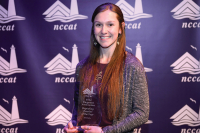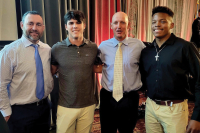Ash bats and the boys of summer
Some essays get to their point or points right away. Others are discursive, beating around the bush before getting there. Or they may not, in fact, have a discernable point. This one, I suspect, will fall somewhere between the latter two categories.
As I write, it’s the morning of Monday, April 2, 2007. The official Major League Baseball season opened last night with the Mets defeating the Cardinals, the defending world champions, in St. Louis. But my personal baseball season won’t open until the Braves play the Phillies in Philadelphia this afternoon.
My team was the Brooklyn Dodgers throughout the 1950s until they moved to Los Angeles in 1958. During the early 1960s, I didn’t root for any particular team, but I began following the Braves since 1966, when the franchise was moved from Milwaukee to Atlanta. There were a lot of lean years, but, of course, the Braves have been on a roll of late, winning 14 straight National League East Division championships before last year’s slip up.
I generally prefer to listen to baseball games on the radio. But it helps to see a few games on TV or, better yet, in person so as to sharpen my mental images of the new players, coaches, and the setting at Turner Field. Accordingly, I’m been studying the Braves schedule and my schedule to see when I can best hustle down to Atlanta and catch a “twofer”; that is, a Saturday night game followed by a Sunday afternoon game.
I prefer to go to ball games by myself. And I insist on arriving early enough to watch the Braves take pre-game batting practice. For whatever reason, that’s one of my favorite rituals. I like watching the individual swings of each player, and I love the rich sound created when a baseball collides with the sweet spot of a wooden bat. Note I specified “a wooden bat.” The puny hollow pinging sound made when an aluminum bat strikes a baseball is an atrocity, a perversion of reality.
Related Items
That’s the prime reason I don’t often attend college or high school baseball games. Their use of aluminum bats is driven by justifiable economic concerns, of course. Wooden bats, which break are or cracked with frequency, are expensive. Aluminum bats, for all I know, last forever.
Hang on. We’re starting to get to the point of this essay, maybe. Most experts are agreed that the baseball bats which generate the most satisfying sounds are those made from white ash. Furthermore, much of the white ash harvested for use as bats, especially during the first half of the twentieth century, originated in the eastern mountains.
When Babe Ruth hit his 60th home run, he did it with a bat made from white ash. Ditto Roger Maris when he hit his asterisk-marked 61st homer. Double-ditto Hank Aaron when he poleaxed number 755. Barry Bonds will probably surpass Aaron’s record for the most lifetime homers this season. Since I don’t care much for Barry Bonds as a player or as a person, I’m pleased that he won’t be using a bat crafted from white ash when he does so. He prefers, instead, “A certain species of Canadian maple.”
OK, having made my point, I need a conclusion. Let’s do it this way.
In his wonderful book titled A Natural History of Trees of Eastern & Central North America (Boston: Houghton Mifflin Co., 1950), Donald Culross Peattie — who once, by the way, lived in Tryon — penned this tribute to the white ash:
“Every American boy knows a great deal about white ash wood. He knows the color of its yellowish white sapwood and the pale brown grain of the annual growth layers in it. He knows the weight of white ash not in terms of pounds per cubic foot but by the more immediate and unforgettable sensation of having lifted and swung a piece of it, of standard size. He knows even its precise resonance and pitch, the ringing ‘tonk’ of it when struck. For it is of white ash, and of white ash only, that good baseball bats are made. Ash is the commonest wood for the frames of tennis racquets, for swing seats, for hockey sticks, for polo mallets, and playground equipment. The reasons why it is the favorite wood for sporting goods are found in its fundamental properties; it is tough, too tough to break under much strain, but pliant, and just pliant enough, not too much so. It can be bent into desired shapes and worked with comparative ease, yet it is hard. Despite its great strength, ash is comparatively light.”
Go Braves!
George Ellison wrote the biographical introductions for the reissues of two Appalachian classics: Horace Kephart’s Our Southern Highlanders and James Mooney’s History, Myths, and Sacred Formulas of the Cherokees. In June 2005, a selection of his Back Then columns was published by The History Press in Charleston as Mountain Passages: Natural and Cultural History of Western North Carolina and the Great Smoky Mountains. Readers can contact him at P.O. Box 1262, Bryson City, N.C., 28713, or at This email address is being protected from spambots. You need JavaScript enabled to view it..









